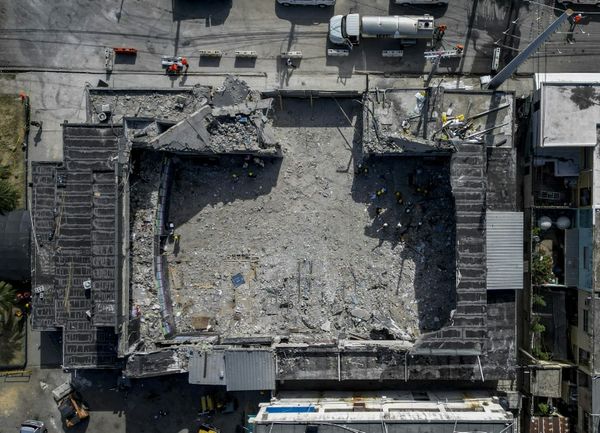
There are not many portraits you wait all your adult life to see, but so it is with A Man Suffering from Delusions of Military Rank, painted by Théodore Géricault some time after The Raft of the Medusa in 1819. This shattering image of a man with no name is in Britain for the first time, loaned by a small Swiss museum a dozen miles outside Zurich.
To see it with your own eyes is to have a sense of who this man might really be, whether the title seems right, and why Géricault painted him in the first place: all of them unresolved mysteries.
The man is gaunt and elderly and sunk in anxiety, or suspicion. He looks away from us towards some other world. He is dressed – or dressed up, perhaps by somebody else? – in white shirt, black gilet and cloth sash over one shoulder. Around his neck hangs what looks to modern eyes like a dog tag, numbered 121, and on his head is a tattered hat with red piping and tassel. Perhaps it is the hat of Napoleon’s military police, hence the delusions of rank. Or perhaps the tag gives the number of his hospital ward.
But all the historic interpretations of this painting – that this is a study of monomania, painted for a Parisian doctor specialising in madness – fall away when you stand before the actual portrait. Géricault has sat with this man in Paris, heard him breathe or even speak, watched his gaze slide away into the distance. Who knows where or for how long he has been confined. The portrait is so empathetic and dignified, but so loose in its excitable rapidity, that Géricault’s own state of mind becomes part of the picture’s content. It is anything but a diagnostic illustration.
One of a fabled series of 10 “insane” portraits, scattered after Géricault’s premature death at 32, it disappeared for years, eventually bought by the Swiss art collector Oskar Reinhart (1885-1965) in the 1920s. It has been hanging in his pristine white villa in Winterthur ever since. The private collection of this Hanseatic merchant became a public museum in the 1950s, and now a tranche of its greatest masterpieces has arrived in the once-private collection of his merchant contemporary Samuel Courtauld in London. Goya to Impressionism is a jewel of an exhibition.
Everything startles – not least because until quite recently this collection, like the Barnes in Philadelphia or the Frick in New York, was not allowed to travel, at its owner’s request. Now that this statute has expired, it is possible to see Goya’s dark and staggering still life of three chunks of bleeding flesh heaped together c.1812 (like the severed limbs painted by Géricault not many years later). In fact you are looking at salmon steaks, larger than life, huddled together round a fallen armoury of glittering silver scales. Crimson paint seeps from them, and into the canvas like blood. Goya is painting this dead flesh during the horrors of the Peninsular war.
So many of these paintings are much larger than reproduction could ever imply. Cézanne’s formidable early portrait of his uncle, eyes hidden beneath heavy brows, is monumental: the paint standing proud of the canvas in slabs. Renoir’s immense calla lily, surrounded by tubs of hothouse plants, outstrips nature’s grandeur in its colossal upright flash. The Géricault is much bigger than expected: a prominence that carries its own significance.
Courbet’s enormous rising wave, a green pyramid at the centre of a turbulent sea, powered forwards by the menacing rows of waves behind it, was painted with a palette knife off the coast of Normandy in 1870. The froth is flecked with particles, like fragments of rock. It comes at you with such force – a momentary closeup on an overwhelming scale – that it is uplifting to learn that Cézanne felt the same on seeing one of these wave paintings. “It hits you right in the stomach. You have to step back.”
Reinhart was passionate about French painting, and the origins of impressionism in the work of Daumier, Corot and Courbet, for instance, all strongly represented here. But the sense is that he prized each painting for its own sake. He waited years to buy certain pictures (lists exist), even decades for Manet’s Au café, painted in 1878.
One half of a bar scene that Manet slashed in two – both sides will soon be reunited at the National Gallery – this image of three Parisians seated at a bar listening, looking, dreaming, is so strange and distinct. Precise and yet otherworldly, it irresistibly recalls the artist’s A Bar at the Folies-Bergère, hanging nearby in the Courtauld Gallery. The central figure’s moustache drifts away like smoke on the air.
Reinhart chose brilliant and singular paintings. Not just any Renoir of rosy girls in sun-dappled Montmartre but a sharp-eyed portrait of Victor Chocquet, humble customs official and early patron of the artist. Not just any whiplash Toulouse-Lautrec but an enigmatic portrait of an elusive entertainer at the Moulin Rouge – a female clown and contortionist called Cha-U-Kao – passing through the syrupy light of the bar in arsenic green knickerbockers, pausing momentarily to dart an undeceived glance at someone or something offstage.
Cézanne’s watercolour of Mont Sainte-Victoire, possibly painted in the last year of his life, is pure exhilaration. By now the hot sky and parched white rock of this eternal landscape near Aix-en-Provence are fading out, compared to the thrill of the foreground. Roof, shrubs and trees, all painted in translucent overlapping colours, are as complex as the glowing oil painting of fruit that hangs on the opposite wall, and as radiant as any stained glass.
Every painting speaks to those just outside this show, by the same artists, in the Courtauld; and every work alters and deepens the understanding of these painters. Although there are only 25 masterpieces, they amount to a condensed museum within a museum. If there is the slightest chance of seeing them in London before the end of May, try to visit, before they require a pilgrimage to Switzerland once more.
Linder Sterling’s retrospective at the Hayward Gallery, also opening last week, is overdue but thorough. Subtitled Danger Came Smiling, it shows the British collagist extraordinaire (born 1954) at full stretch. Here are all the radical classics: the ambiguous photographs of herself in perfect eyeliner, but with smudged lipstick and holes in her top, or with her whole face squished sideways in clingfilm. The nude with an iron for a head and smiling mouths for nipples, used on the cover of a 1977 Buzzcocks single.
What women are supposed to be goes with what they look like. Black-and-white shots of consumer durables are superimposed on the heads or torsos of soft-porn nudes. Women’s faces are overlaid with oversized lipsticked mouths. A whole wall of them shows the endless inflections, sarcastic to terrified, of all those mismatched smiles.
Linder’s fusion of exploitation with politics runs to late-flowering surrealism – elegiac adaptations of old photographs of Russian ballet stars. There are unaltered photographs of drag queens in Scottish nightclubs and of Morrissey getting a manicure. There are also numerous collages of porn models, their exposed genitals covered up with big bright flowers.
The problem of showing each series at exhaustive length, no matter how sharp, is most obvious when you see how original Linder can be. A work from 1976 shows a man clasping an apparently compliant woman by the waist. But she is holding a fork to her own eyes. Linder’s collage is proverbial.
Star ratings (out of five)
Goya to Impressionism ★★★★★
Linder: Danger Came Smiling ★★★
Goya to Impressionism: Masterpieces from the Oskar Reinhart Collection is at the Courtauld Gallery, London, until 26 May
Linder: Danger Came Smiling is at the Hayward Gallery, London, until 5 May







